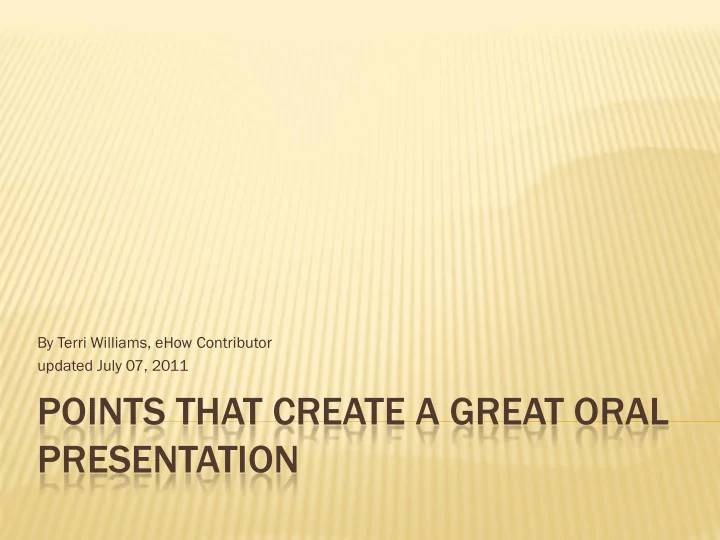

By Terri Williams, eHow Contributor updated July 07, 2011 POINTS THAT CREATE A GREAT ORAL PRESENTATION
When used tastefully, visual props are an effective way to complement your presentation. The devil is in the details, and you should be too so you can avoid producing the type of mind-numbingly dull oral presentation that has become standard fare. It is generally understood -- and unhappily accepted -- that most oral presentations are remarkably uninteresting, extremely repetitive and generally tiresome.
However, with a few pointers, you can break through the humdrum muddle of mediocrity and create oral presentations that are appealing, interesting and informative.
1. KNOW YOUR INFORMATION There is no substitute for being prepared. Know your information inside out, backward and forward. The best way for you to look like you know what you're talking about is to actually know what you're talking about. Don't tread into unfamiliar territory. Cover only the information that you can knowledgeably and comfortably share with your audience.
You need to project an air of confidence during your presentation, and this won't be possible unless you are at ease. Also, it's true that practice makes perfect. Rehearse your presentation until you can convey it without reading from notes (a definite "no"), manufacturing unnecessary pauses or using phrases like, "And uh . . .".
2. LIMIT YOUR INFORMATION While you need to be an expert, realize that your audience doesn't want to know -- and doesn't have the attention span to absorb -- everything that you know about your presentation topic. It will require discipline on your part to narrow your focus, and then narrow it again, until you can select only a few of the most important (and interesting) points to share.
For example, if you're doing an oral presentation on how technology can improve workplace efficiency, don't spend ten minutes discussing how the first computer was an abacus used in 300 B.C. by the Babylonians. According to Forbes.com, "speakers must make only their strongest points, and work hard to refine them down to their most concise and eloquent essence."
3. USE BELLS AND WHISTLES JUDICIOUSLY Slide show presentations and other visual props can be an effective way to add flair. However, used incorrectly, they can ruin an otherwise promising presentation. Spinning text is a nice effect; however, if it requires an additional 10 seconds for each bullet point to stop spinning, or if the text spins so rapidly that it makes the audience dizzy, use static text instead.
Bells and whistles should complement your oral presentation. They shouldn't be the primary focus. "Presentation Tips for Public Speaking" offers this advice: "Do not over-dazzle your audience with excessive use of animation, sound clips, or gaudy colors which are inappropriate for your topic."
4. VERBAL TECHNIQUES Good vocal techniques require the speaker to speak clearly with correct grammar and pronunciation. If in doubt, the speaker should check these in advance. Modulate your voice to avoid a monotone and speak loudly enough to be heard throughout the room, but not too loud to be distracting.
Use speed effectively. The speaker must not speak so fast that that the audience cannot follow what he is saying. Use pauses for effect when appropriate to emphasize items or to give the audience time to think about what is being said. Variety contributes to an effective delivery. A necessary technique is to include such words as "also" or "in addition," which promote smooth transitions between ideas.
5. NON-VERBAL TECHNIQUES Maintaining eye contact is fundamental. Look around at the audience to enhance communication and glance at notes only when necessary. Body language and gestures are fundamental for effective speech delivery. Stand straight to give the appearance of confidence. Keep your hands out of your pockets. Movement is another technique to consider.
6. CONTROLLING NERVOUSNESS TECHNIQUE Speakers can be nervous because they fear appearing foolish. To overcome this, be prepared. Record or practice in front of friends. Arrive early and build confidence by telling yourself that you can do it. Breathe deeply before you begin and wiggle your toes for relaxation. Using these techniques should result in an effective speech delivery.
Recommend
More recommend